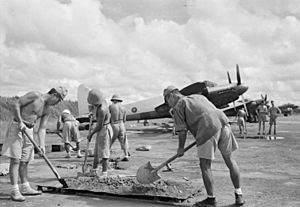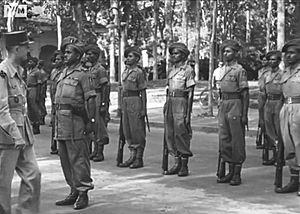War in Vietnam (1945–1946) facts for kids
Quick facts for kids War in Vietnam |
||||||||
|---|---|---|---|---|---|---|---|---|
| Part of the Indochina Wars and the Cold War | ||||||||
 A Japanese naval officer surrendering his sword to a British naval lieutenant in Saigon on 13 September 1945 |
||||||||
|
||||||||
| Belligerents | ||||||||
|
|
|
|||||||
| Commanders and leaders | ||||||||
| Strength | ||||||||
| Unknown number of soldiers | Unknown number of soldiers | At least 15,000 Hòa Hảo militants Unknown number of Cao Đài and VNQDD forces Some 2,500 Bình Xuyên forces |
||||||
| Casualties and losses | ||||||||
| British estimation: 2,700 dead (600 by British forces, the rest by French and Japanese) |
Unknown | |||||||
The 1945–46 War in Vietnam was a short but important conflict. The British called it Operation Masterdom. The Vietnamese called it the Southern Resistance War. It happened right after World War II.
This war involved British, Indian, French, and Japanese soldiers. They fought against the Vietnamese communist group called the Viet Minh. The fight was for control of southern Vietnam. The conflict ended with the French regaining control. This then led to the First Indochina War.
Contents
Why the War Started: Background
In July 1945, world leaders met in Germany. They decided to divide Indochina (which included Vietnam) into two parts. The northern part was for Chinese forces. The southern part was for British forces. Their job was to accept the surrender of Japanese troops.
The leaders agreed that France should own Indochina again. But France was weak after being occupied by Germany. So, British and Indian troops were sent to help France. They helped France take back control of its former colony.
After Japan surrendered in August 1945, British forces prepared to go to Vietnam. Their main goals were to keep order, disarm Japanese soldiers, and help prisoners of war. However, there was a delay. The main Allied commander, General Douglas MacArthur, wanted to accept Japan's surrender himself first.
This delay created a big problem in Vietnam. Japanese forces had already removed French control in March 1945. They set up a new Vietnamese government. When the Japanese surrendered, a power vacuum appeared. This meant there was no strong government in charge.
Revolutionary groups quickly took over public buildings. The Viet Minh, led by Ho Chi Minh, was a strong nationalist group. They used this chance to seize control. Ho Chi Minh declared Vietnam's independence on September 2, 1945. The Japanese did not stop them. They did not want the French to return easily.
The United States and other Allies agreed that France had the right to control Indochina. But America did not have strong feelings against the Viet Minh at first.
Chinese Troops in Northern Vietnam
Around August 1945, about 200,000 Chinese soldiers entered northern Vietnam. Their job was to disarm the Japanese troops there. These Chinese soldiers were not the best trained. They were from different warlord groups.
Vietnamese nationalist fighters also came with the Chinese. Ho Chi Minh's government had to provide food for the Chinese soldiers. The Chinese stayed in northern Vietnam until April–June 1946. They wanted to prevent France from returning. They hoped Vietnam would become independent under Chinese guidance.
British Involvement in the South
Major General Douglas Gracey arrived in Saigon on September 13. He quickly saw how serious the situation was. Saigon's government services had collapsed. The Viet Minh had taken power. Japanese soldiers were still armed, which worried the Allies.
Gracey also had trouble communicating with his commanders. His American communication team was suddenly removed. This made things even harder for him. Gracey felt that if he did not act fast, the chaos would get worse.
The Viet Minh did not have full control over all their allied groups. This allowed the French to convince Gracey to rearm some French prisoners of war. Gracey agreed to arm about 1,000 former French prisoners. He believed this was the fastest way for France to regain control. This would also help him disarm the Japanese.
Gracey also had disagreements with his superior, Lord Mountbatten. Gracey declared martial law in southern Indochina. Mountbatten thought Gracey went too far. But other British leaders supported Gracey's decision.
Over the next few days, Gracey slowly took control of Saigon. He replaced Viet Minh guards with his own troops. These positions were then handed over to French troops. This was done because the Viet Minh would not give up their positions directly to the French.
Allies Take Back Control of Saigon
By September 23, most of Saigon was back in French hands. French soldiers, including newly arrived troops, pushed the Viet Minh out. Two French soldiers died in this action.
After this, some French people in Saigon celebrated. But they also rioted against the local Vietnamese population. On September 24-25, a Vietnamese group attacked a district in Saigon. They killed and kidnapped many French civilians.
At the same time, the Viet Minh set up roadblocks around Saigon. They shot at French people trying to leave. An American agent was accidentally killed. Elsewhere, the Viet Minh attacked the city's market and the Tan Son Nhut Airfield. British Gurkha soldiers fought back at the airfield. One British soldier and several Viet Minh were killed. The British now found themselves in a war.
For the next few days, armed Viet Minh groups fought British patrols. The Viet Minh suffered many losses. British soldiers were experienced. They had just fought the Japanese. Many also knew about fighting guerrillas. The Viet Minh, however, were still learning how to fight.
In early October, Gracey talked with the Viet Minh. They agreed to a truce. On October 5, General Philippe Leclerc, a senior French commander, arrived in Saigon. His troops were placed under Gracey's command.
However, the truce ended on October 10. A British engineering team was attacked near the airfield. Most of them were killed or wounded. Gracey realized he had to secure key areas before sending the Japanese home. His forces grew stronger with more troops arriving.
British planes saw that roads to Saigon were blocked. The Viet Minh were trying to cut off the city. On October 13, Tan Son Nhut Airfield was attacked again. Viet Minh commandos got close to the control tower. Indian and Japanese soldiers stopped the attack.
By mid-October, many Viet Minh had been killed by British, Indian, and Japanese troops. British, French, and Japanese casualties were much lower. More British troops arrived on October 17.
Viet Minh Attacks Continue
The Viet Minh then attacked important places in Saigon. These included the power plant, docks, and airfield. Saigon often had blackouts at night. Sounds of gunfire and explosions were common. The Viet Minh could not take Saigon. So, they focused on siege tactics, trying to cut off the city. French troops helped break the siege. British patrols kept the Viet Minh off balance.
On October 29, the British formed a strong team. This team was called 'Gateforce'. Their goal was to push the Viet Minh further away from Saigon. This force included Indian infantry, artillery, and Japanese soldiers. They killed many Viet Minh during their operations.

On November 18, Gurkha soldiers went to Long Kien to rescue French hostages. They met strong Viet Minh resistance and had to turn back. A stronger force was sent later. The Gurkhas said they saw Japanese deserters leading some Viet Minh groups. During this operation, the Gurkhas used their traditional knives, called kukris, in a charge. They killed about 80 Viet Minh. No hostages were found.
By early December, Gracey handed over Saigon's northern areas to the French. Many new French soldiers were former French Resistance fighters. They were not used to strict military rules.
In the South Central Highlands, the Viet Minh forced French troops out of many villages. The Vietnamese recaptured the town of Buôn Ma Thuột in mid-December. British planes attacked the Viet Minh on December 11.
The last big battle between the British and Viet Minh happened on January 3, 1946. About 900 Viet Minh attacked a British camp. The fighting lasted all night. About 100 attackers were killed. No British or Indian soldiers died.
The End of the Campaign
By mid-January, the Viet Minh stopped large attacks. They started using new tactics. These included ambushes, quick raids, and assassinations. The British, French, and Japanese constantly patrolled. This was one of the first modern unconventional wars. The Viet Minh had many fighters. But they were beaten back by well-trained soldiers.
By the end of January, the British handed over their areas to the French. General Gracey left on January 28. He gave control of French forces to General Leclerc. The last main British forces left Vietnam on March 26. This ended their seven-month involvement. On March 30, the last British and Indian battalions left by ship. Only a small group remained to guard a mission in Saigon. They left on May 15. The French then took over getting the remaining Japanese soldiers home.
What Happened Next: Aftermath
For Britain's part in this war, 40 British and Indian soldiers were killed. French and Japanese casualties were a little higher. About 2,700 Viet Minh were killed. Around 600 of these were killed by British forces. The rest were killed by French and Japanese troops. The exact number of Viet Minh dead is hard to know.
Why This War Was Important
This short conflict led to many more years of fighting. Some historians believe that if the British had stayed, the Viet Minh might have been defeated. This could have changed the future of communism in Vietnam.
From March to July 1946, the Viet Minh worked to remove their rivals. This was called the "Great Purge." They wanted to get rid of anyone who seemed dangerous to the Communist Party.
Between May and December 1946, Ho Chi Minh spent four months in France. He tried to get full independence for Vietnam. But he failed to get any promises from the French. After some violent clashes, French forces attacked Haiphong harbor. They captured Haiphong and tried to push the Viet Minh out of Hanoi. This took two months.
December 19, 1946, is often seen as the start date of the First Indochina War. On that day, 30,000 Viet Minh soldiers attacked the French in Hanoi. The long war in Vietnam had begun.
See also
- Operation Beleaguer
- Operation Blacklist Forty
- Occupation of Japan



